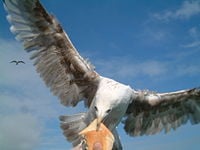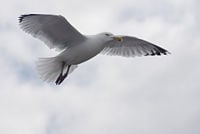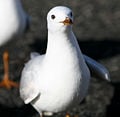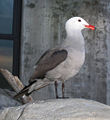Gull
- "Seagull" redirects here.
| Gulls | ||||||||||||
|---|---|---|---|---|---|---|---|---|---|---|---|---|
 Black-headed Gull
| ||||||||||||
| Scientific classification | ||||||||||||
| ||||||||||||
|
Larus |
Gull is the common name for any of the aquatic birds comprising the family Laridae, characterized by long and narrow wings, strong bills that are hooked at the end, webbed feet, and normally white or gray plumage with gray or black markings on the head or wings. They are chiefly coastal birds, found near all oceans, but also are found commonly in various inland waters.
In common usage, members of various gull species are often referred to as sea gulls or seagulls. This name is used by layman to refer to a common local species or all gulls in general, and has no fixed taxonomic meaning.
For humans living along temperate coastal areas, gulls are a ubiquitous part of the landscape, adding to the wonder of nature. Ecologically, they are important components of food chains, consuming various crustaceans, fish, mollusks, and insects, while their young and eggs are consumed by various vertebrate predators on land and in the ocean.
Some taxonomies consider terns as a subfamily of Laridae, although there is a tendency now to consider them their own family, Sternidae.
Description
Gulls are typically medium to large birds. They range in size from the little gull, at 120 grams (4.2 ounces) and 29 centimeters (11.5 inches) in length, to the great black-backed gull, at 1.75 kilograms (3.8 pounds) and 76 centimeters (30 inches).
Gulls tend to be heavily built. They have long and narrow wings for flying and webbed feet for swimming; the wingspan ranges from two to five feet. Gulls have stout, long bills with a slight hook on the end.
There are about 50 species of gulls, with most in the genus Larus. Apart from the kittiwakes, gulls are typically coastal or inland species, rarely venturing far out to sea. The kittiwakes, which comprise two species in the genus Rissa, are oceanic gulls that are rarely found on land. Gulls are very common in coastal areas in temperate and arctic areas in the Northern Hemisphere.
Most gulls, particularly Larus species, are ground nesting carnivores, which will take live food or scavenge opportunistically. The live food often includes crabs and small fish, as well as mollusks and insects, and even small rodents. The young and eggs are subject to predation from mammals, snakes, and predatory birds, while even the adults may be at risk from sharks and larger predatory birds.
The large species take up to four years to attain full adult plumage, but two years is typical for small gulls. Nesting areas may be some distance from where gulls are actually seen flying or scavenging for food, and parental gulls can be highly protective of their eggs and young.
Gulls—the larger species in particular—are resourceful and highly-intelligent birds, demonstrating complex methods of communication and a highly-developed social structure; for example, many gull colonies display mobbing behavior, attacking and harassing would-be predators and other intruders (Alcock 1998). In addition, certain species (e.g. the herring gull) have exhibited tool use behavior. Many species of gull have learned to co-exist successfully with man and have thrived in human habitats. Others rely on kleptoparasitism (taking prey from another animals that has caught it) to get their food.
Classification
Fifty-five extant species in six genera are recognized in the list of species below, with 49 of the species in the genus Larus and two species in Rissa. Only one species is placed in each of the remaining four genera, Pagophila, Rhodostethia, Xema, and Creagus.
Gulls are most closely related to the terns (family Sternidae), which previously had been considered a subfamily of Laridae (van Tuinen et al. 2004). The American Ornithologists' Union continues to combine Sternidae, Stercorariidae (skuas or jaegers), and Rhynchopidae (skimmers) as subfamilies in the family Laridae. However, recent research (Paton et al. 2003; Thomas et al. 2004; Paton and Baker 2006) indicates that this is incorrect.
Gulls are only distantly related to auks and skimmers, and more distantly to the waders. Most gulls belong to the large genus Larus.
Two terms are in common usage among gull enthusiasts for sub-groupings of the gulls:
- Large white-headed gulls for the 16 Herring Gull-like species from great black-backed gull to lesser black-backed gull in the taxonomic list below.
- White-winged gulls for the two Arctic-breeding species Iceland gull and glaucous gull.
Hybridization between species of gull occurs quite frequently, although to varying degrees depending on the species involved. The taxonomy of the large white-headed gulls is particularly complicated.
List of gulls in taxonomic order
Genus Larus
- Dolphin Gull, Larus scoresbii
- Pacific Gull, Larus pacificus
- Belcher's Gull, Larus belcheri
- Olrog's Gull, Larus atlanticus
- Black-tailed Gull, Larus crassirostris
- Gray Gull, Larus modestus
- Heermann's Gull, Larus heermanni
- White-eyed Gull, Larus leucophthalmus
- Sooty Gull, Larus hemprichii
- Common Gull or Mew Gull, Larus canus
- Audouin's Gull, Larus audouinii
- Ring-billed Gull, Larus delawarensis
- California Gull, Larus californicus
- Great Black-backed Gull, Larus marinus
- Kelp Gull, Larus dominicanus
- Glaucous-winged Gull, Larus glaucescens
- Western Gull, Larus occidentalis
- Yellow-footed Gull, Larus livens
- Glaucous Gull, Larus hyperboreus
- Iceland Gull, Larus glaucoides
- Thayer's Gull, Larus thayeri
- Herring Gull, Larus argentatus
- Heuglin's Gull, Larus heuglini
- American Herring Gull, Larus smithsonianus
- Yellow-legged Gull, Larus michahellis
- Caspian Gull, Larus cachinnans
- East Siberian Herring Gull, Larus vegae
- Armenian Gull, Larus armenicus
- Slaty-backed Gull, Larus schistisagus
- Lesser Black-backed Gull, Larus fuscus
- Great Black-headed Gull, Larus ichthyaetus
- Brown-headed Gull, Larus brunnicephalus
- Grey-headed Gull, Larus cirrocephalus
- Hartlaub's Gull, Larus hartlaubii
- Silver Gull, Larus novaehollandiae
- Red-billed Gull, Larus scopulinus
- Black-billed Gull, Larus bulleri
- Brown-hooded Gull, Larus maculipennis
- Black-headed Gull, Larus ridibundus
- Slender-billed Gull, Larus genei
- Bonaparte's Gull, Larus philadelphia
- Saunders' Gull, Larus saundersi
- Andean Gull, Larus serranus
- Mediterranean Gull, Larus melanocephalus
- Relict Gull, Larus relictus
- Lava Gull, Larus fuliginosus
- Laughing Gull, Larus atricilla
- Franklin's Gull, Larus pipixcan
- Little Gull, Larus minutus
Genus Rissa
- Black-legged Kittiwake, Rissa tridactyla
- Red-legged Kittiwake, Rissa brevirostris
Genus Pagophila
- Ivory Gull, Pagophila eburnea
Genus Rhodostethia
- Ross's Gull, Rhodostethia rosea
Genus Xema
- Sabine's Gull, Xema sabini
Genus Creagrus
- Swallow-tailed Gull, Creagrus furcatus
The Laridae are known from fossil evidence since the Early Oligocene, some 30-33 mya. A fossil gull from the Late Miocene of Cherry County, USA is placed in the prehistoric genus Gaviota; apart from this and the undescribed Early Oligocene fossil, all prehistoric species are at least tentatively assigned to the modern genus Larus, q.v.
Gallery
Western Gull in Monterey, United States
Gull chick at Trondheim, Norway
A Black-headed Gull in Devon, England
The Swallow-tailed Gull, endemic inhabitant of the Galápagos Islands.
Silver Gull at Sale, Australia
Ring-billed Gulls at Chesapeake Bay
Ring-billed Gull at Toronto, Ontario, Canada
ReferencesISBN links support NWE through referral fees
- Alcock, J. 1998. Animal Behavior: An Evolutionary Approach, sixth edition. Sunderland, MA: Sinauer Associates. ISBN 0878930094.
- Olsen, K. M., and H. Larsson. 1995. Terns of Europe and North America. London: Christopher Helm. ISBN 0713640561.
- Paton, T. A., and A. J. Baker. 2006. Sequences from 14 mitochondrial genes provide a well-supported phylogeny of the Charadriiform birds congruent with the nuclear RAG-1 tree. Molecular Phylogenetics and Evolution 39(3): 657–667. Retrieved November 5, 2007.
- Paton, T. A., A. J. Baker, J. G. Groth, and G. F. Barrowclough. 2003. RAG-1 sequences resolve phylogenetic relationships within charadriiform birds. Molecular Phylogenetics and Evolution 29: 268-278. Retrieved November 5, 2007.
- Thomas, G. H., M. A. Wills, and T. Székely. 2004. A supertree approach to shorebird phylogeny. BMC Evol. Biol. 4: 28. Retrieved November 5, 2007.
- van Tuinen, M., D. Waterhouse, and G. J. Dyke. 2004. Avian molecular systematics on the rebound: a fresh look at modern shorebird phylogenetic relationships. Journal of Avian Biology 35(3): 191-194.
External links
All links retrieved June 21, 2024.
- The Norwegian Gull Page: Huge picture archive including all NW European species, as well as features from the Nearctic and SE Europe.
- Bird pictures - Gulls: Pictures and descriptions of large gulls from The Netherlands, France, Spain and Poland.
Credits
New World Encyclopedia writers and editors rewrote and completed the Wikipedia article in accordance with New World Encyclopedia standards. This article abides by terms of the Creative Commons CC-by-sa 3.0 License (CC-by-sa), which may be used and disseminated with proper attribution. Credit is due under the terms of this license that can reference both the New World Encyclopedia contributors and the selfless volunteer contributors of the Wikimedia Foundation. To cite this article click here for a list of acceptable citing formats.The history of earlier contributions by wikipedians is accessible to researchers here:
The history of this article since it was imported to New World Encyclopedia:
Note: Some restrictions may apply to use of individual images which are separately licensed.


















